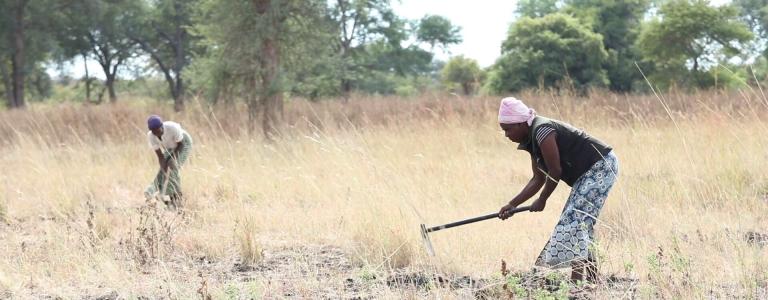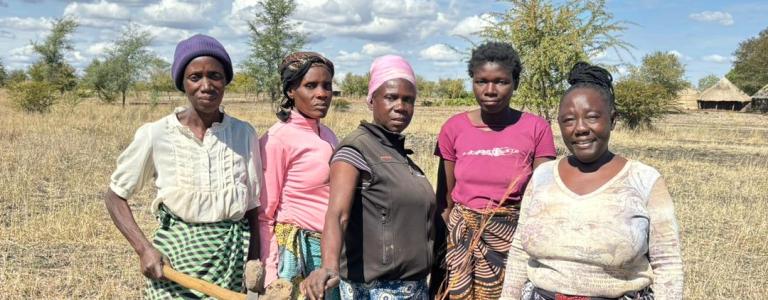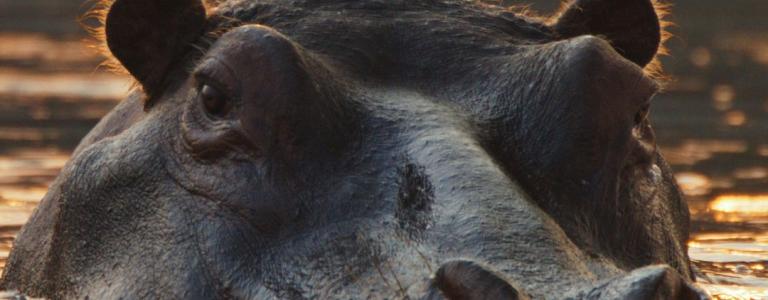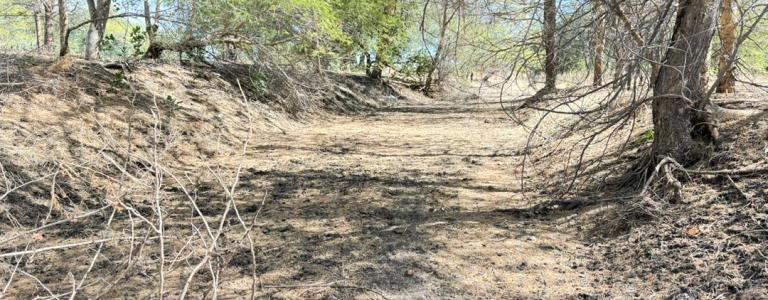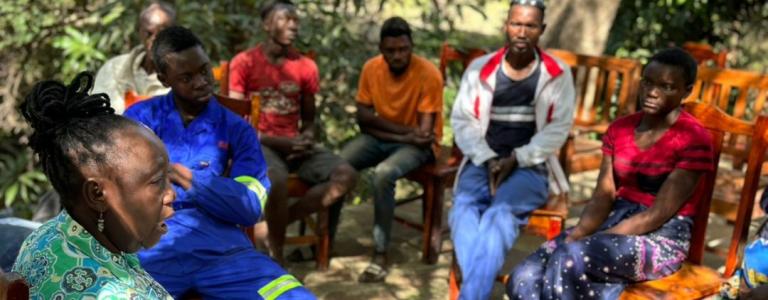Hope Springs: How one community brought a river back from the brink
For over a decade, a small group of community members in Zambia have been working to restore the Nsongwe River, once a precious sanctuary for wildlife and the community. Their actions are slowly but surely bringing the river back to life. Now, with support from IISD’s Climate Adaptation and Protected Areas Initiative, their goal is within reach. Susan Sekirime explains.
As the world gears up to celebrate World Rivers Day on September 22, we should take a moment to reflect on the vital role that rivers have played in sustaining human evolution.
Rivers are one of the world’s most precious resources, but they are invariably undervalued. Long before we engineered running water, rivers flowed through our landscapes, pumping fresh water to wetlands and lakes and out to sea. Animals and plants found sanctuary in the rivers, fish swam in their waters, and birds flew overhead. Vegetation was replenished by seeds carried by rivers for thousands of miles, while a multitude of species used rivers as migration routes. These waterways did not just sustain life on Earth, they were also part of the fabric of our culture and history, shaping identities of entire nations. The valleys of some great rivers contain many sites of early human settlement, and for centuries, rivers served as trade routes across the globe, influencing the economic, social, political, and religious development of mankind.
Today, these values still exist, and in some ways, are even more significant than before. An estimated 2 billion people globally rely directly on rivers for their drinking water, while about 500 million live on deltas that are sustained by sediment from rivers. But in a world where our climate is rapidly changing, and the global population is expected to increase by nearly 2 billion in the next 30 years, rivers are under pressure. There is a critical need to protect and preserve these invaluable natural resources.
The Nsongwe community, some 30 minutes outside of Mosi-oa-Tunya National Park in southern Zambia, knows this all too well. The Nsongwe River, a spring-fed waterway that was once their lifeline and sanctuary, is no more the victim of poor planning and neglect. However, over a period of 13 years, a small group of community members have been working to desilt, reforest, and restore parts of the river. We spoke to one of the local women from the village, Bridget Meyer, who kicked off this work and has been leading the river’s restoration, and asked her to share her story.
What do you remember about the Nsongwe River growing up?
“I remember the river being vibrant with life and flowing all year round through the heart of a lush forest. We revered the Nsongwe River not only as a recreational spot for swimming but also for its healing waters believed to possess curative properties that could soothe ailments and restore well-being.
The cool, clear waters, shaded by a thick canopy above, offered a serene escape from the heat.
As a young girl, the Nsongwe River was a big recreation area for me and my friends. We spent our weekends enjoying the cool breeze along the river as we collected a special grass to make baskets. We chased butterflies along the Nsongwe River corridor, believing that you would receive a beautiful and colourful gift at Christmas resembling the colour of the butterfly you caught. We swam every day. A section of the river was lined with a wall of basalt rock on which girls and boys listed love notes in chalk. Gossip and other communal information was exchanged on this wall. At any one point in the afternoons, there would be about 10 or more girls swimming and enjoying the river. We made sound echoes that bounced off the rock wall.
A special wild pea with big pods grew every rainy season. We harvested the pods and squeezed one edge that would pop open. We used the opening to slide in our earlobes and wear as earrings. We wore them for Christmas! I really cherish those moments.
The river did not only appeal to the locals who dwelled near it; it was also a critical habitat for wildlife, most notably the hippos. The dense forest and the abundant water provided the hippos with everything they needed: safety from predators, lush vegetation for grazing, and ample space to submerge and keep cool under the hot sun.
The Nsongwe River was more than just a body of water; it was a sanctuary, both for the communities who dwelled near it and the wildlife that called it home.
What is the state of the Nsongwe River today?
“The river has undergone a very dramatic transformation. Currently, it stands mostly dry, its former glory significantly diminished. Many of the deep pools that dotted its course have been filled with soil and sand, a testament to the neglect and environmental degradation it has suffered.
The lush forest that once lined its banks, providing shade and a cool microclimate, has been largely cleared. The removal of these trees not only took away the river’s natural cooling mechanism but also exposed the surrounding land to the harsh sun. This deforestation has had a domino effect, leading to increased erosion along the riverbanks. The soil, once held firmly in place by the roots of countless trees, has washed away, leaving behind barren and eroded fields.
Without the protective cover of the forest and the sustaining waters of the river, the local wildlife has suffered. The hippos, which once brought their young to grow and thrive in the safety of the Nsongwe River’s waters, no longer visit. The river, devoid of its life-giving flow, cannot support them, nor the fish.
The community, too, feels the absence of the river's bounty. Swimming, a joyful and communal activity that also served as a respite from the heat, is no longer possible. The river, which once healed and nurtured, now serves as a stark reminder of the fragility of natural ecosystems and the profound impact of human activity on the environment.”
What has the community done to successfully restore the river?
“Over a period of 13 years, a small group of community members have been working to desilt, reforest, and restore parts of the river. To date, we have managed to remove soil deposits and plant native hydrophilic plants along a 300-metre stretch of the riverbank.
We pumped water from our well to a drinking trough for cattle away from the river to protect the restoration works. These actions, albeit very minimal, have restored some natural springs that had been buried, and the area where we concentrated our efforts has started showing signs of life.
In the vast dryness that has characterized the Nsongwe community for several decades, this stretch is now a cool, green haven.
Community members have started gathering to cool off in the water, and a lone crocodile has also taken permanent residence in the area.
This success serves as a beacon of hope and has sparked a wave of renewed optimism among the local community and conservationists alike that the entire river could potentially be returned to its former state.
What would it mean to the community if the Nsongwe River started flowing again?
“Revitalizing the Nsongwe River would bring numerous benefits, both ecological and economic.
For the village, the resurgence of the river could lead to a revival of local activities and traditions that were once centred around its waters. Swimming and fishing, activities that foster community bonding and support local livelihoods, could once again thrive.
The return of clean, flowing water would also ensure the health and sustainability of local gardens, boosting food production and supporting self-sufficiency.
Moreover, the restoration of the forest surrounding the river would be equally good. Replanting trees and rehabilitating the forest would not only help stabilize the climate around the river by providing much-needed shade and reducing erosion, but would also reestablish a habitat for wildlife, including the once-common hippos. The cooler microclimate would make the area more comfortable for both residents and visitors, enhancing the village’s appeal as a destination for ecotourism.
Such environmental restoration could catalyze economic revitalization. With the river and forest restored, new opportunities could arise in ecotourism and agroforestry, providing jobs and stimulating economic activity. Local markets could see a surge in demand for agricultural products and crafts, further energizing the village’s economy.
In essence, the restoration of the Nsongwe River and its surrounding forest is not just an ecological necessity but a cornerstone for the future prosperity of the village, fostering a sustainable model that could inspire similar efforts elsewhere. That is why the work we are doing with the Climate Adaptation and Protected Areas Initiative is so important!”
The work already done by the community was the proof of concept that Climate Adaptation and Protected Areas (CAPA) partners IISD and WWF Zambia needed to scale up the nature-based solutions that the community had achieved. With support from Global Affairs Canada, the CAPA Initiative is now supporting the Nsongwe community to restore the river and its tributaries, the Lubemba and Lutwa streams.
So far, this has meant conducting risk assessments to better understand the unique climate, biodiversity, and gender risks faced by the community, alongside hydrological assessments to identify areas suitable for specific restoration efforts, including desilting and the construction of check dams to control water velocity, conserve soil, and improve the land.
Through CAPA, IISD and WWF Zambia have managed to get the whole community involved, including their Senior Chief—who has since encouraged villages outside of the CAPA target area to do the same.
Beyond the river itself, CAPA is also supporting the community in restoring 400 hectares of forest along the Nsongwe River and is constructing fire breaks along a 50-metre buffer zone on both sides of the river to protect the restored areas. These efforts will support effective water recharge, flow, and availability during the dry seasons, thereby contributing to efforts to revive the Nsongwe—which once ran for 5 kilometres before joining the Zambezi—to its former glory.
This work is part of CAPA’s efforts to design and implement concrete gender-responsive, conflict-sensitive, nature-based solutions to support local communities to adapt to climate change while safeguarding critical ecosystems and biodiversity in and around protected areas in the Kavango–Zambezi landscape.
What started as a one-woman effort, with support from a few community members, is now a whole community effort, and we are proud to be working alongside them to restore the whole river and two of its tributaries.
Learn more about what we are doing in the Kavango–Zambezi Landscape.
Participating experts
You might also be interested in
How to Make Nature-Based Solutions for Adaptation Work for Everyone
Effective nature-based solutions (NbS) for adaptation start with integrated climate risk assessments. These take-aways will help practitioners plan for inclusive and sustainable NbS.
Biodiversity Is in Crisis—Here's one way to fix it
A growing movement of projects and partnerships is using locally driven and gender-responsive nature-based solutions to address the twin crises of climate change and biodiversity loss. Scaling up this work to match the urgency and reach of the crises will be a challenge—but it’s one we must embrace.
What Is the NAP Assessment at COP 29, and Why Does It Matter?
At the 29th UN Climate Change Conference (COP 29) in Baku, countries will assess their progress in formulating and implementing their National Adaptation Plans. IISD’s adaptation experts Orville Grey and Jeffrey Qi explain what that means, and what’s at stake.
IISD Annual Report 2023–2024
While IISD's reputation as a convenor, a trusted thought leader, and a go-to source on key issues within the sustainable development field is stronger than ever, the work happening outside the spotlight is just as valuable.
